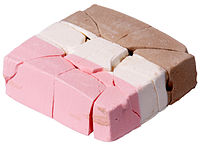
Photo from wikipedia
Lyophilization, also known as freeze drying, is a widely used method for stabilization, improvement of long-term storage stability, and simplification of handling of drugs and/or carrier systems. Lyophilization is time-consuming… Click to show full abstract
Lyophilization, also known as freeze drying, is a widely used method for stabilization, improvement of long-term storage stability, and simplification of handling of drugs and/or carrier systems. Lyophilization is time-consuming and energy-consuming, and hence optimized processes are required to avoid time loss and higher costs without compromising product stability. Beginning from the last decade, nonviral, synthetic carriers for gene delivery have been of increasing interest. However, these systems suffer from poor physical stability in aqueous solution or suspension. Hence, to ensure long-term storage stability lyophilization of the gene carrier systems is favored. This chapter gives an overview of the basic steps and troubleshooting for successful lyophilization of synthetic gene carriers. Furthermore, the required excipients and their mechanism of action are summarized.
Journal Title: Methods in molecular biology
Year Published: 2019
Link to full text (if available)
Share on Social Media: Sign Up to like & get
recommendations!